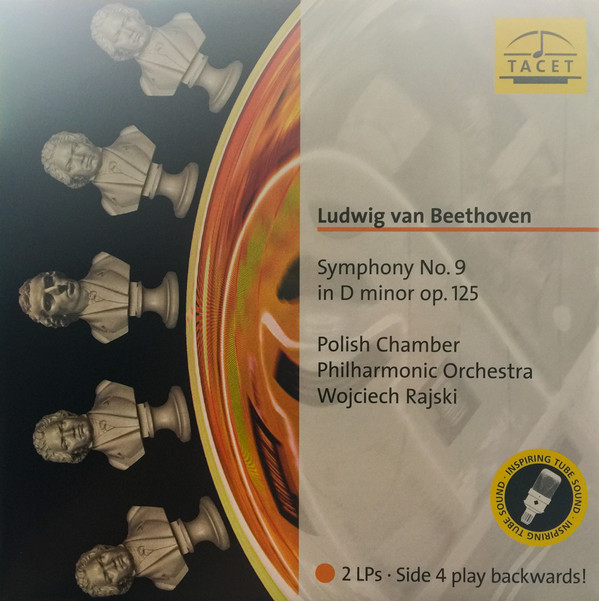
| Лейбл та номер: | Tacet – L 219 |
| Формат платівки: | 2 Вініла, LP |
| Країна виробник: | Germany |
| Рік випуску: | 2016 |
| Музичний жанр: | Классика |
| Музичні стилі: | Классика |
Пісні:
| Название песни | Время звучания |
|---|---|
| Allegro Ma Non Troppo, Un Poco Maestoso | 13:43 |
| Molto Vivace | 12:42 |
| Adagio Molto E Cantabile | 13:11 |
| Presto – Allegro Assai (Play Backwards) | 21:32 |
Додатково:
Polish Chamber Choir
Schola Cantorum Gedanensis
(Jan Łukaszewski – conductor)
Recorded in St. John’s Church in Gdansk, 2015
Technical Equipment: TACET
Translations: Celia Skrine (English) Katherine Wren (English)
Cutting: Daniel Krieger, SST Bruggemann GmbH, Frankfurt
IMPORTANT EXPLANATORY NOTES FOR PLAYING SIDE 4
The first three movements – sides 1, 2 and 3 – should be played back as normal. For the last movement on side 4, please place the needle on the inside of the record. You needn’t do any more than that: it will move from the inside to the outside of the record. The music sounds so much the better than in a normal production. Don’t worry, nothing will happen. If you place the needle on the outside, either by accident or through habit, it will land in the continuous loop of the lead-out groove. If you lower it too far inside, nothing happens either. The correct lead-in groove starts a bit further away from the central hole, so not quite on the inside of the record, apart from anything else so that it does not trigger the limit-stop. From there, the needle must start travelling.
The reason side 4 functions differently from the normal lies in the music itself. The final movement of the 9th symphony places enormous demands on vinyl technology. To start with it is long, and secondly, the loudest point comes at the end. The further the tone arm travels towards the inside of the record in a normal way, the more information per centimetre must be accommodated due to the constant rotational speed o the turntable. If the needle traverses a distance of about 40cm in one revolution per turntable, then for a frequency of 10,000 Hertz it must move left and right 25 times over just 1mm. That might still work, so long as you’re dealing with a quiet sound. However, as the volume increases, so does the deflection and thus the problems increase: loss of high frequencies, distortion, etc. are the result. Therefore, it has always been difficult to accommodate this movement with its extremely loud conclusion on one side of an LP, and to be able to achieve flawless playback quality. With TACET’s reverse playback, the most technically difficult places are on the outside, where the LP sounds best.
This reverse playback of the 4th movement therefore improves the playback on your system. Enjoy the refined, but energetic performance by the Polish Chamber Philharmonic Orchestra, the opulent voices, the jubilant choir and the elegant, exciting direction by Wojciech Rajski in St. John’s Church in Gdansk, Poland.